by Calculated Risk on 11/12/2021 04:20:00 PM
Friday, November 12, 2021
November 12th COVID-19: New Cases Stuck Above 70,000 per Day
| COVID Metrics | ||||
|---|---|---|---|---|
| Today | Week Ago | Goal | ||
| Percent fully Vaccinated | 58.7% | 58.2% | ≥70.0%1 | |
| Fully Vaccinated (millions) | 194.7 | 193.2 | ≥2321 | |
| New Cases per Day3🚩 | 73,218 | 71,249 | ≤5,0002 | |
| Hospitalized3 | 39,359 | 41,692 | ≤3,0002 | |
| Deaths per Day3 | 999 | 1,101 | ≤502 | |
| 1 Minimum to achieve "herd immunity" (estimated between 70% and 85%). 2my goals to stop daily posts, 37 day average for Cases, Currently Hospitalized, and Deaths 🚩 Increasing 7 day average week-over-week for Cases, Hospitalized, and Deaths ✅ Goal met. | ||||
IMPORTANT: For "herd immunity" most experts believe we need 70% to 85% of the total population fully vaccinated (or already had COVID). Note: COVID will probably stay endemic (at least for some time).
The following 19 states have between 50% and 59.9% fully vaccinated: Wisconsin at 58.9%, Nebraska, Iowa, Utah, Michigan, Texas, Kansas, Arizona, Nevada, South Dakota, North Carolina, Alaska, Ohio, Kentucky, Montana, Oklahoma, South Carolina, Missouri and Indiana at 50.2%.
Next up (total population, fully vaccinated according to CDC) are Georgia at 48.8%, Tennessee at 48.8%, Arkansas at 48.6%, Louisiana at 48.2% and North Dakota at 48.1%.
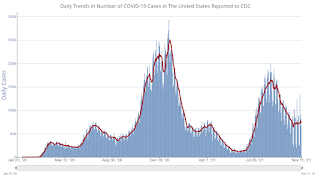 Click on graph for larger image.
Click on graph for larger image.This graph shows the daily (columns) and 7 day average (line) of positive tests reported.
Q4 GDP Forecasts: Around 5% to 6%
by Calculated Risk on 11/12/2021 12:13:00 PM
From BofA:
Our 3Q GDP tracking estimate increased to 2.5% qoq saar from 2.1%, following positive inventory revisions. We remain at 6.0% for 4Q [November 12 estimate]From Goldman Sachs
emphasis added
We boosted our past-quarter GDP tracking estimate for Q3 by one tenth to +2.2% (qoq ar) but left our Q4 GDP tracking estimate unchanged at +4.5% (qoq ar). [November 10 estimate]And from the Altanta Fed: GDPNow
The GDPNow model estimate for real GDP growth (seasonally adjusted annual rate) in the fourth quarter of 2021 is 8.2 percent on November 10, down from 8.5 percent on November 4. [November 10 estimate]
BLS: Job Openings "Little Changed" at 10.4 Million in September
by Calculated Risk on 11/12/2021 10:06:00 AM
From the BLS: Job Openings and Labor Turnover Summary
The number of job openings was little changed at 10.4 million on the last business day of September, the U.S. Bureau of Labor Statistics reported today. Hires and total separations were little changed at 6.5 million and 6.2 million, respectively. Within separations, the quits level and rate increased to a series high of 4.4 million and 3.0 percent, respectively. The layoffs and discharges rate was unchanged at 0.9 percent.The following graph shows job openings (yellow line), hires (dark blue), Layoff, Discharges and other (red column), and Quits (light blue column) from the JOLTS.
emphasis added
This series started in December 2000.
Note: The difference between JOLTS hires and separations is similar to the CES (payroll survey) net jobs headline numbers. This report is for September, the most recent employment report was for October.
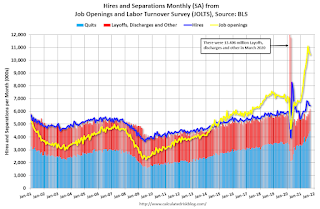 Click on graph for larger image.
Click on graph for larger image.Note that hires (dark blue) and total separations (red and light blue columns stacked) are usually pretty close each month. This is a measure of labor market turnover. When the blue line is above the two stacked columns, the economy is adding net jobs - when it is below the columns, the economy is losing jobs.
The huge spike in layoffs and discharges in March 2020 are labeled, but off the chart to better show the usual data.
Jobs openings decreased in September to 10.438 million from 10.629 million in August.
The number of job openings (yellow) were up 58% year-over-year.
Quits were up 34% year-over-year to a new record high. These are voluntary separations. (see light blue columns at bottom of graph for trend for "quits").
Black Knight: Number of Mortgages in Forbearance Declines
by Calculated Risk on 11/12/2021 08:29:00 AM
This data is as of November 9th.
From Andy Walden at Black Knight: Mortgage Loans in Forbearance Drop Below 2% Entering November
Forbearance plan exit volumes increased week-over-week heading into November as the share of mortgage loans in forbearance fell below 2% for the first time since the early stages of the pandemic.
According to our McDash Flash daily mortgage performance dataset, the number of loans in active forbearance fell 123,000 (-10.8%). The week’s strongest declines were among loans held in bank portfolios and private label securities, which recorded a reduction of 59,000 (-15.9%). FHA/VA plans also showed significant improvement, declining by 48,000 (-11.3), while GSE loans in forbearance plans decreased by 16,000 (-4.8%).
As of November 9, 1.01 million mortgage holders remain in COVID-19 related forbearance plans, representing 1.9% of all active mortgages, including 1.2% of GSE, 3.1% of FHA/VA and 2.4% of portfolio/PLS loans.
Click on graph for larger image.
Nearly 300,000 borrowers have left their plans over the past two weeks down from 455,000 over the same two-week period last month as we hit the downslope of exit activity. That said, more than 250,000 plans are still listed with October/November reviews for extension/removal. Half of those are expected to reach final expiration, which could lead to continued improvement, albeit at a slower pace, in the weeks ahead.
Plan entries were down 9% from a week ago, logging one of the lowest weeks in terms of new entries since the onset of the pandemic.
emphasis added
Thursday, November 11, 2021
Friday: Job Openings
by Calculated Risk on 11/11/2021 08:01:00 PM
Friday:
• At 10:00 AM ET, Job Openings and Labor Turnover Survey for September from the BLS. Jobs openings decreased in August to 10.439 million from 11.098 million in July.
• Also at 10:00 AM, University of Michigan's Consumer sentiment index (Preliminary for November).
3rd Look at Local Housing Markets in October
by Calculated Risk on 11/11/2021 01:36:00 PM
Today, in the Real Estate Newsletter: 3rd Look at Local Housing Markets in October
Excerpt:
This is the third look at local markets in October. This update adds Albuquerque, Atlanta, Colorado, Houston, Jacksonville, Minnesota, Portland, Sacramento and Santa Clara.You can subscribe at https://calculatedrisk.substack.com/ (Currently all content is available for free, but please subscribe).
...
Here is a summary of active listings for the housing markets that have reported so far in October. For these markets, inventory was down 7.9% in October MoM from September, and down 25.1% YoY.
Of the markets that have reported so far, inventories in Jacksonville and San Diego are at record lows. Sacramento is the only market so far with inventory up YoY in October.
Inventory almost always declines seasonally in October, so the MoM decline is not a surprise. Last month, these markets were down 22.9% YoY, so the YoY decline in October is slightly larger than in September. This is not indicating a slowing market.
Hotels: Occupancy Rate Down 13% Compared to Same Week in 2019
by Calculated Risk on 11/11/2021 11:12:00 AM
Note: Since occupancy declined sharply at the onset of the pandemic, CoStar is comparing to 2019.
U.S. hotel performance increased slightly from the previous week, according to STR‘s latest data through November 6.The following graph shows the seasonal pattern for the hotel occupancy rate using the four week average.
October 31 through November 6, 2021 (percentage change from comparable week in 2019*):
• Occupancy: 59.8% (-13.0%)
• Average daily rate (ADR): $128.14 (-3.2%)
• Revenue per available room (RevPAR): $76.61 (-15.8%)
*Due to the steep, pandemic-driven performance declines of 2020, STR is measuring recovery against comparable time periods from 2019.
emphasis added
 Click on graph for larger image.
Click on graph for larger image.The red line is for 2021, black is 2020, blue is the median, dashed purple is 2019, and dashed light blue is for 2009 (the worst year on record for hotels prior to 2020).
"The deal of the Century ..."
by Calculated Risk on 11/11/2021 08:50:00 AM
This morning, in the Real Estate Newsletter: "The deal of the Century ..."
A few real estate words of wisdom from my dad, and a salute to all veterans!
Wednesday, November 10, 2021
November 10th COVID-19: New Cases Increasing
by Calculated Risk on 11/10/2021 04:20:00 PM
| COVID Metrics | ||||
|---|---|---|---|---|
| Today | Week Ago | Goal | ||
| Percent fully Vaccinated | 58.5% | 58.1% | ≥70.0%1 | |
| Fully Vaccinated (millions) | 194.4 | 192.7 | ≥2321 | |
| New Cases per Day3🚩 | 74,584 | 70,960 | ≤5,0002 | |
| Hospitalized3 | 39,852 | 42,552 | ≤3,0002 | |
| Deaths per Day3 | 1,078 | 1,125 | ≤502 | |
| 1 Minimum to achieve "herd immunity" (estimated between 70% and 85%). 2my goals to stop daily posts, 37 day average for Cases, Currently Hospitalized, and Deaths 🚩 Increasing 7 day average week-over-week for Cases, Hospitalized, and Deaths ✅ Goal met. | ||||
IMPORTANT: For "herd immunity" most experts believe we need 70% to 85% of the total population fully vaccinated (or already had COVID). Note: COVID will probably stay endemic (at least for some time).
The following 19 states have between 50% and 59.9% fully vaccinated: Wisconsin at 58.8%, Nebraska, Iowa, Utah, Michigan, Texas, Kansas, Arizona, Nevada, South Dakota, North Carolina, Alaska, Ohio, Kentucky, Montana, Oklahoma, South Carolina, Missouri and Indiana at 50.1%.
Next up (total population, fully vaccinated according to CDC) are Georgia at 48.8%, Tennessee at 48.7%, Arkansas at 48.5%, Louisiana at 48.1% and North Dakota at 48.0%.
 Click on graph for larger image.
Click on graph for larger image.This graph shows the daily (columns) and 7 day average (line) of positive tests reported.
Housing: Inventory will Tell the Tale
by Calculated Risk on 11/10/2021 02:01:00 PM
Today, in the Real Estate Newsletter: Inventory will Tell the Tale
Excerpt:
We are being flooded with housing stories. Will house prices decline or will price growth just slow? Does the US have a housing shortage? If mortgage rates rise to 4%, will that “halt the housing market” as Ivy Zelman said on CNBC?You can subscribe at https://calculatedrisk.substack.com/ (Currently all content is available for free, but please subscribe).
Although my crystal ball is cloudy at this point, I believe inventory will tell the tale. That is why I watch inventory closely. Not just the monthly existing home sales report from the National Association of Realtors (NAR) and the monthly new home sales report from the Census Bureau. I also use weekly data from Altos Research (See Altos’ Mike Simonsen’s weekly presentation on YouTube).
And I track inventory and sales for 30+ local markets each month.
...
My Spidey senses are tingling, however it isn't obvious why this time - or what the outcome will be.
But I believe one thing is certain: inventory will tell the tale!
Cleveland Fed: Median CPI increased 0.6% and Trimmed-mean CPI increased 0.7% in October
by Calculated Risk on 11/10/2021 11:56:00 AM
The Cleveland Fed released the median CPI and the trimmed-mean CPI this morning:
According to the Federal Reserve Bank of Cleveland, the median Consumer Price Index rose 0.6% in October. The 16% trimmed-mean Consumer Price Index increased 0.7% in October. "The median CPI and 16% trimmed-mean CPI are measures of core inflation calculated by the Federal Reserve Bank of Cleveland based on data released in the Bureau of Labor Statistics’ (BLS) monthly CPI report".
Note: The Cleveland Fed released the median CPI details for September here. "Fuel oil and other fuels" were up 193% annualized.
 Click on graph for larger image.
Click on graph for larger image.This graph shows the year-over-year change for these four key measures of inflation.
MBA: "Mortgage Delinquencies Decrease in the Third Quarter of 2021"
by Calculated Risk on 11/10/2021 10:11:00 AM
From the MBA: Mortgage Delinquencies Decrease in the Third Quarter of 2021
The delinquency rate for mortgage loans on one-to-four-unit residential properties decreased to a seasonally adjusted rate of 4.88 percent of all loans outstanding at the end of the third quarter of 2021, according to the Mortgage Bankers Association’s (MBA) National Delinquency Survey.
For the purposes of the survey, MBA asks servicers to report loans in forbearance as delinquent if the payment was not made based on the original terms of the mortgage. The delinquency rate was down 59 basis points from the second quarter of 2021 and down 277 basis points from one year ago.
“For the fifth consecutive quarter, the mortgage delinquency rate declined, commensurate with a decline in the U.S. unemployment rate over the same time period,” said Marina Walsh, CMB, MBA’s Vice President of Industry Analysis. “The improvement was driven entirely by a decline in later-stage delinquent loans – those loans that are 90 days or past due, but not in foreclosure. By the end of the third quarter, many borrowers were approaching the 18-month expiration point of their forbearance terms and were being placed in permanent home retention solutions, such as modifications and loan deferrals.”
Walsh added, “Once these borrowers entered permanent post-forbearance workouts and resumed payments, they moved from delinquent to current status.”
emphasis added
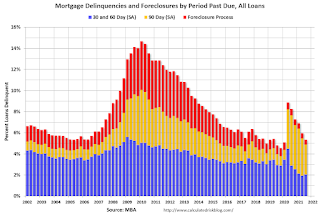 Click on graph for larger image.
Click on graph for larger image.This graph shows the percent of loans delinquent by days past due. Overall delinquencies decreased in Q3.
From the MBA:
Compared to last quarter, the seasonally adjusted mortgage delinquency rate decreased for all loans outstanding. By stage, the 30-day delinquency rate increased 10 basis points to 1.51 percent, the 60-day delinquency rate remained unchanged at 0.52 percent, and the 90-day delinquency bucket decreased 68 basis points to 2.85 percent.This sharp increase last year in the 90-day bucket was due to loans in forbearance (included as delinquent, but not reported to the credit bureaus).
...
The delinquency rate includes loans that are at least one payment past due but does not include loans in the process of foreclosure. The percentage of loans in the foreclosure process at the end of the third quarter was 0.46 percent, down 5 basis points from the second quarter of 2021 and 13 basis points lower than one year ago. This is the lowest foreclosure inventory rate since the fourth quarter of 1981. The percentage of loans on which foreclosure actions were started in the third quarter fell by 1 basis point to 0.03 percent, which is the lowest starts rate reported in the survey and consistent with the last three quarters of 2020.
The percent of loans in the foreclosure process declined further, and was at the lowest level since 1981.
Weekly Initial Unemployment Claims Decrease to 267,000
by Calculated Risk on 11/10/2021 08:37:00 AM
The DOL reported:
In the week ending November 6, the advance figure for seasonally adjusted initial claims was 267,000, a decrease of 4,000 from the previous week's revised level. This is the lowest level for initial claims since March 14, 2020 when it was 256,000. The previous week's level was revised up by 2,000 from 269,000 to 271,000. The 4-week moving average was 278,000, a decrease of 7,250 from the previous week's revised average. This is the lowest level for this average since March 14, 2020 when it was 225,500. The previous week's average was revised up by 500 from 284,750 to 285,250.The following graph shows the 4-week moving average of weekly claims since 1971.
emphasis added
 Click on graph for larger image.
Click on graph for larger image.The dashed line on the graph is the current 4-week average. The four-week average of weekly unemployment claims decreased to 278,000.
The previous week was revised up.
Regular state continued claims increased to 2,160,000 (SA) from 2,101,000 (SA) the previous week.
Weekly claims were above consensus forecast.
BLS: CPI increased 0.9% in October, Core CPI increased 0.6%
by Calculated Risk on 11/10/2021 08:32:00 AM
The Consumer Price Index for All Urban Consumers (CPI-U) increased 0.9 percent in October on a seasonally adjusted basis after rising 0.4 percent in September, the U.S. Bureau of Labor Statistics reported today. Over the last 12 months, the all items index increased 6.2 percent before seasonal adjustment.Both CPI and core CPI were well above expectations. I'll post a graph later today after the Cleveland Fed releases the median and trimmed-mean CPI.
The monthly all items seasonally adjusted increase was broad-based, with increases in the indexes for energy, shelter, food, used cars and trucks, and new vehicles among the larger contributors. The energy index rose 4.8 percent over the month, as the gasoline index increased 6.1 percent and the other major energy component indexes also rose. The food index increased 0.9 percent as the index for food at home rose 1.0 percent.
The index for all items less food and energy rose 0.6 percent in October after increasing 0.2 percent in September. Most component indexes increased over the month. Along with shelter, used cars and trucks, and new vehicles, the indexes for medical care, for household furnishing and operations, and for recreation all increased in October. The indexes for airline fares and for alcoholic beverages were among the few to decline over the month.
The all items index rose 6.2 percent for the 12 months ending October, the large st 12-month increase since the period ending November 1990. The index for all items less food and energy rose 4.6 percent over the last 12 months, the largest 12-month increase since the period ending August 1991. The energy index rose 30.0 percent over the last 12 months, and the food index increased 5.3 percent.
emphasis added
MBA: Mortgage Applications Increase in Latest Weekly Survey
by Calculated Risk on 11/10/2021 07:00:00 AM
From the MBA: Mortgage Applications Increase in Latest MBA Weekly Survey
Mortgage applications increased 5.5 percent from one week earlier, according to data from the Mortgage Bankers Association’s (MBA) Weekly Mortgage Applications Survey for the week ending November 5, 2021.
... The Refinance Index increased 7 percent from the previous week and was 28 percent lower than the same week one year ago. The seasonally adjusted Purchase Index increased 3 percent from one week earlier. The unadjusted Purchase Index increased 0.1 percent compared with the previous week and was 4 percent lower than the same week one year ago.
“Mortgage rates moved lower for the second week in a row for all loan types. The 30-year fixed rate decreased to 3.16 percent and has declined 14 basis points over the past two weeks. Although overall activity remains close to January 2020 lows, homeowners acted on the decrease in rates. Refinance activity was up 7 percent overall, with gains in both conventional and government refinances. Additionally, the average loan balance for a refinance application was the highest in a month,” said Joel Kan, MBA’s Associate Vice President of Economic and Industry Forecasting. “Purchase applications were also strong last week, increasing just under 3 percent and down only 4 percent from last year’s pace. The dip in rates might have helped to bring some buyers back into the market, but housing inventory is still extremely low and price growth remains elevated.”
...
The average contract interest rate for 30-year fixed-rate mortgages with conforming loan balances ($548,250 or less) decreased to 3.16 percent from 3.24 percent, with points remaining unchanged at 0.34 (including the origination fee) for 80 percent loan-to-value ratio (LTV) loans.
emphasis added
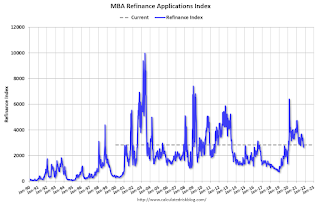 Click on graph for larger image.
Click on graph for larger image.The first graph shows the refinance index since 1990.
With relatively low rates, the index remains somewhat elevated, and the recent decline in rates has given the index a slight boost.
The second graph shows the MBA mortgage purchase index
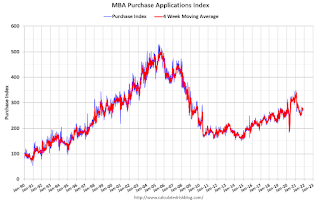 According to the MBA, purchase activity is down 4% year-over-year unadjusted.
According to the MBA, purchase activity is down 4% year-over-year unadjusted.This is the smallest year-over-year decline in some time (purchase activity was strong in the 2nd half of 2020). However, this week last year was weak - so it is likely the year-over-year decline will be larger in coming weeks.
Note: Red is a four-week average (blue is weekly).
Tuesday, November 09, 2021
Wednesday: CPI, Unemployment Claims
by Calculated Risk on 11/09/2021 08:01:00 PM
Wednesday:
• At 7:00 AM ET, The Mortgage Bankers Association (MBA) will release the results for the mortgage purchase applications index.
• At 8:30 AM, The Consumer Price Index for October from the BLS. The consensus is for a 0.6% increase in CPI, and a 0.4% increase in core CPI.
• At 8:30 AM, The initial weekly unemployment claims report will be released. The consensus is for 260 thousand initial claims, down from 269 thousand last week.
November 9th COVID-19: 16 Days till Thanksgiving and New Cases Stuck at 70,000+ per Day
by Calculated Risk on 11/09/2021 04:24:00 PM
| COVID Metrics | ||||
|---|---|---|---|---|
| Today | Week Ago | Goal | ||
| Percent fully Vaccinated | 58.5% | 58.0% | ≥70.0%1 | |
| Fully Vaccinated (millions) | 194.2 | 192.6 | ≥2321 | |
| New Cases per Day3 | 73,312 | 75,209 | ≤5,0002 | |
| Hospitalized3 | 39,841 | 43,056 | ≤3,0002 | |
| Deaths per Day3 | 1,078 | 1,211 | ≤502 | |
| 1 Minimum to achieve "herd immunity" (estimated between 70% and 85%). 2my goals to stop daily posts, 37 day average for Cases, Currently Hospitalized, and Deaths 🚩 Increasing 7 day average week-over-week for Cases, Hospitalized, and Deaths ✅ Goal met. | ||||
IMPORTANT: For "herd immunity" most experts believe we need 70% to 85% of the total population fully vaccinated (or already had COVID). Note: COVID will probably stay endemic (at least for some time).
The following 20 states have between 50% and 59.9% fully vaccinated: Wisconsin at 58.7%, Nebraska, Iowa, Illinois, Michigan, Kentucky, South Dakota, Texas, Arizona, Kansas, Nevada, Alaska, Utah, North Carolina, Ohio, Montana, Oklahoma, South Carolina, Indiana, and Missouri at 50.1%.
Next up (total population, fully vaccinated according to CDC) are Georgia at 48.8%, Arkansas at 48.4%, Tennessee at 48.1% and Louisiana at 48.0%.
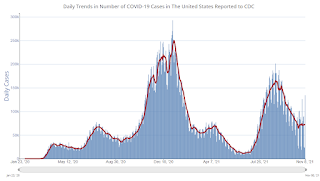 Click on graph for larger image.
Click on graph for larger image.This graph shows the daily (columns) and 7 day average (line) of positive tests reported.
2nd Look at Local Housing Markets in October: Memphis, Nashville, New Hampshire, North Texas (Dallas) and San Diego.
by Calculated Risk on 11/09/2021 01:31:00 PM
Today, in the Real Estate Newsletter: 2nd Look at Local Housing Markets in October
Excerpt:
Here is a summary of active listings for the housing markets that have reported so far in October. For these markets, inventory was down 9.6% in October MoM from September, and down 30.4% YoY.You can subscribe at https://calculatedrisk.substack.com/ (Currently all content is available for free, but please subscribe).
Inventory in San Diego is at an all time low!
Inventory almost always declines seasonally in October, so the MoM decline is not a surprise. Last month, these eight markets were down 27.4% YoY, so the YoY decline in October is larger than in September. This is not indicating a slowing market (but this is just 8 early reporting markets).
NY Fed Q3 Report: Total Household Debt Climbs to Over $15 trillion
by Calculated Risk on 11/09/2021 11:17:00 AM
From the NY Fed: Total Household Debt Climbs to Over $15 trillion in Q3 2021, Driven by New Extensions of Credit
The Federal Reserve Bank of New York's Center for Microeconomic Data today issued its Quarterly Report on Household Debt and Credit. The Report shows that total household debt increased by $286 billion (1.9%) to $15.24 trillion in the third quarter of 2021. The total debt balance is now $1.1 trillion higher than at the end of 2019. It is also $890 billion higher than in Q3 2020, and $2.57 trillion higher, in nominal terms, than the $12.68 trillion peak seen in 2008. The Report is based on data from the New York Fed's Consumer Credit Panel, a nationally representative random sample of individual- and household-level debt and credit records drawn from anonymized Equifax credit data.
Mortgage balances—the largest component of household debt—rose by $230 billion and stood at $10.67 trillion at the end of September. Credit card balances increased by $17 billion, the same size increase as in the second quarter. Despite the increase, credit card balances remain $123 billion lower than they had been at the end of 2019. Auto loan balances increased by $28 billion in the third quarter. Student loan balances grew by $14 billion, coinciding with the academic borrowing year. In total, non-housing balances grew by $61 billion, with gains across all debt types.
emphasis added
 Click on graph for larger image.
Click on graph for larger image.Here are three graphs from the report:
The first graph shows aggregate consumer debt increased in Q3. Household debt previously peaked in 2008, and bottomed in Q3 2013. Unlike following the great recession, there wasn't a huge decline in debt during the pandemic.
From the NY Fed:
Aggregate household debt balances increased by $286 billion in the third quarter of 2021, a 1.9% rise from 2021Q2, and now stand at $15.24 trillion. Balances are $1.1 trillion higher than at the end of 2019 and $890 billion higher than in 2020Q3, and $2.57 trillion higher, in nominal terms, than the $12.68 trillion peak seen in 2008.
 The second graph shows the percent of debt in delinquency.
The second graph shows the percent of debt in delinquency.The overall delinquency rate decreased in Q3. From the NY Fed:
Aggregate delinquency rates have remained low and declining since the beginning of the pandemic, reflecting an uptake in forbearances (provided by both the CARES Act and voluntarily offered by lenders), which protect borrowers’ credit records from the reporting of skipped or deferred payments. As of late September, 2.7% of outstanding debt was in some stage of delinquency, a 2.0 percentage point decrease from the fourth quarter of 2019, just before the COVID-19 pandemic hit the United States. Of the $412 billion of debt that is delinquent, $302 billion is seriously delinquent (at least 90 days late or “severely derogatory”, which includes some debts that have been removed from lenders’ books but upon which they continue to attempt collection).
 The third graph shows Mortgage Originations by Credit Score.
The third graph shows Mortgage Originations by Credit Score.From the NY Fed:
The credit scores of newly originated mortgages had increased in the early part of the pandemic, and although they edged down slightly, they still remain very high and reflect a continuing high quality of newly opened mortgages as well as a higher share of refinances. ... There was $1.11 trillion in newly originated mortgage debt in 2021Q3, with 69% of it originated to borrowers with credit scores over 760. 2% of newly originated mortgages were originated to subprime borrowers, a sharp contrast to the 12% average seen between 2003-2007.There is much more in the report.
Second Home Market: South Lake Tahoe in October
by Calculated Risk on 11/09/2021 08:37:00 AM
With the pandemic, there was a surge in 2nd home buying. In response, Fannie made some lending changes, from Jann Swanson at MortgageNewsDaily: Fannie Warns Lenders on Investment Properties and 2nd Homes.
I'm looking at data for some second home markets - and I'm tracking those markets to see if there is an impact from the lending changes.
This graph is for South Lake Tahoe since 2004 through October 2021, and shows inventory (blue), and the year-over-year (YoY) change in the median price (12 month average).
Note: The median price is distorted by the mix, but this is the available data.

Following the housing bubble, prices declined for several years in South Lake Tahoe, with the median price falling about 50% from the bubble peak.
Currently inventory is still very low - above the record low set early in 2021, but down YoY - and prices are up sharply YoY.


